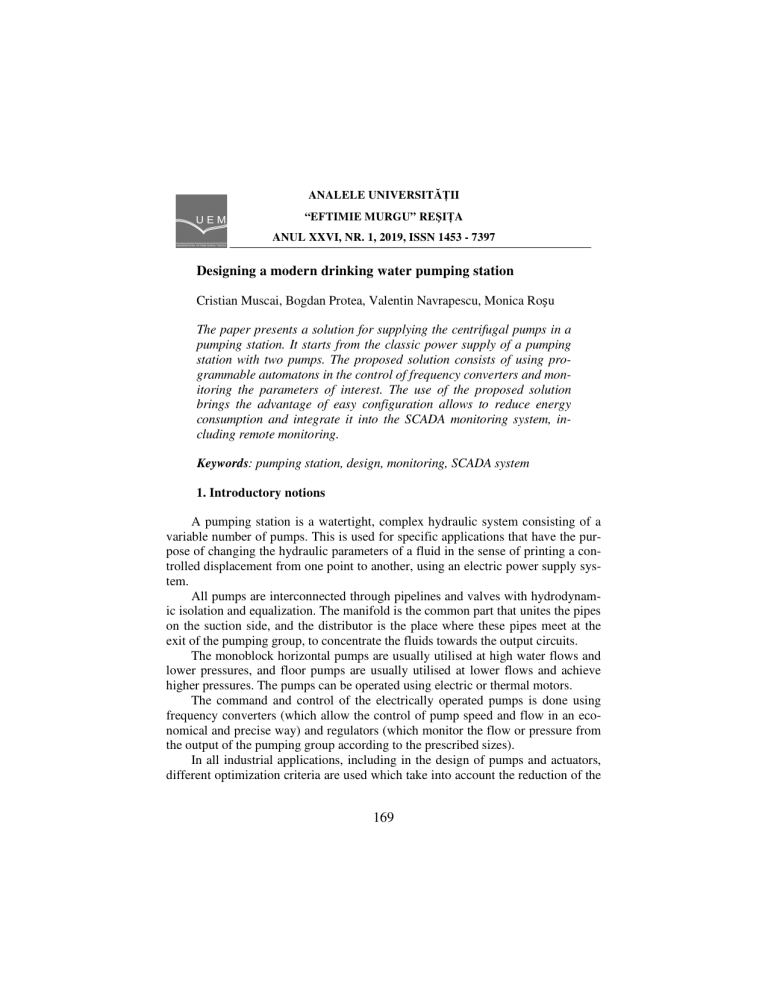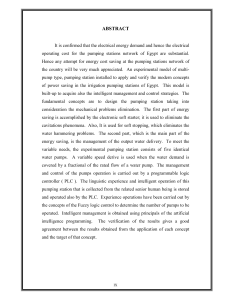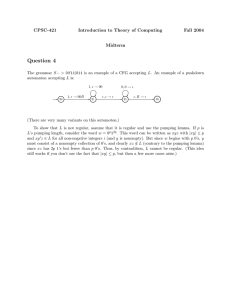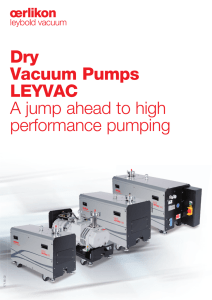
ANALELE UNIVERSITĂŢII “EFTIMIE MURGU” REŞIŢA ANUL XXVI, NR. 1, 2019, ISSN 1453 - 7397 Designing a modern drinking water pumping station Cristian Muscai, Bogdan Protea, Valentin Navrapescu, Monica Roșu The paper presents a solution for supplying the centrifugal pumps in a pumping station. It starts from the classic power supply of a pumping station with two pumps. The proposed solution consists of using programmable automatons in the control of frequency converters and monitoring the parameters of interest. The use of the proposed solution brings the advantage of easy configuration allows to reduce energy consumption and integrate it into the SCADA monitoring system, including remote monitoring. Keywords: pumping station, design, monitoring, SCADA system 1. Introductory notions A pumping station is a watertight, complex hydraulic system consisting of a variable number of pumps. This is used for specific applications that have the purpose of changing the hydraulic parameters of a fluid in the sense of printing a controlled displacement from one point to another, using an electric power supply system. All pumps are interconnected through pipelines and valves with hydrodynamic isolation and equalization. The manifold is the common part that unites the pipes on the suction side, and the distributor is the place where these pipes meet at the exit of the pumping group, to concentrate the fluids towards the output circuits. The monoblock horizontal pumps are usually utilised at high water flows and lower pressures, and floor pumps are usually utilised at lower flows and achieve higher pressures. The pumps can be operated using electric or thermal motors. The command and control of the electrically operated pumps is done using frequency converters (which allow the control of pump speed and flow in an economical and precise way) and regulators (which monitor the flow or pressure from the output of the pumping group according to the prescribed sizes). In all industrial applications, including in the design of pumps and actuators, different optimization criteria are used which take into account the reduction of the 169 manufacturing costs, the operating costs, the constructive and overall dimensions or the total costs [1-3], simultaneously with a safe operation [4-7]. In order to reach functional and energetic optimization, in the control diagrams different programmable automatons are used, which adjust the interest quantities according to the prescribed sizes, the operating regimes and the loading state. The paper presents a solution in the design of the afferent monitoring system of a pumping station using two pumps. The proposed diagram uses modern equipment and technologies that allow the automatic operation of the line, ensuring constant hydraulic parameters, increased efficiency and the possibility of remote monitoring. Worldwide there is a tendency to replace simple, non-automated pumping stations by more energy efficient ones and with the possibility of monitoring and controlling its parameters from a distance. Companies operating in the field of pumps and automation of hydraulic installations propose and realize their own solutions, which allow the integration of the equipment approved in the SCADA applications previously made, at relatively high costs. Most of the times the proposed solution uses a logical and communication structure that works in parallel with the classical one, due to the incompatibilities between existing components on the market and the proposed ones. There are even often high incompatibilities between different generations of pumps and frequency converters made by the same supplier, which complicates the integration of existing equipment even more. Some suppliers have offered built-in frequency converter pumps, which can only be operated with certain controllers, no longer available on the market and whose interfacing with existing automation modules imposes significant costs and determines medium performances determined by the incompatibility with the technical specifications of modern modules. and current. The proposed solution is a general, low and easily scalable solution, allowing the integration of a variable number of pumps, starting from the same structure. The programming software used for HMI and PLC are free, allowing the project to be carried out at lower costs. The proposed PLC is an extendable one, with additional and upgradable input-output modules. The presence of PLC allows automatic operation, long periods of time, even when the communication system fails. Automation, through thermal, electrical and electronic protection systems, invalidates working regimes when faults occur. The communication protocol used is a universal one, implemented by most of the programmable automaton manufacturers. Due to the small number of monitored parameters in the application, the protocol used becomes efficient and does not require high data transfer between SCADA and the pumping station. 170 2. Notions about sizing a pumping station In order to be able to properly dimension a pumping station, we start from the curves that describe the dependence between the working flow and the pumping height (Fig. 1) for the pump chosen, these curves depend on the internal construction and the maximum speeds for which they were sized and are supplied by the manufacturers of these pumps in order to be integrated into the industrial processes. The external characteristics of the pumping stations can be obtained by analytical or experimental methods. Over the graph provided by the manufacturers, the external characteristics of the proposed pumping station are scaled and superimposed [8]. The external characteristic of the system and implicitly the operating point of the pumping group lies at the intersection between the two types of curves (of the system and of the pumps) if they are drawn in the same coordinate system Hpumping height and Q - debit. Figure 1. The optimum operating point for centrifugal pumps. The nominal flow rate of a pumping group is considered to be the flow obtained at its output when all the pumps that make up the pumping group are in operation and are driven at the rated speed. The basic system of the centrifugal pump is made up of one or more radial blades that print to the fluid a centrifugal force dependent on the specific constructive form. 171 Due to the construction and the layout of the machine shaft, the discharge and aspiration pipes are in different planes and involve a more demanding mechanical construction and with an enlarged gauge. For the optimal operation of a pumping station, it is necessary to use a programmable automaton, capable of maintaining the constant hydraulic parameters or to perform the adjustment on the basis of a graph or set reference values. From the logic point of view, the general diagram of a pumping station contains two main parts: the hydraulic part, consisting of the connecting pipes, valves and the pump itself and the electrical part with the control, actuation and control elements. For the design of the pumping station, an adjustment diagram has been drawn up with one or more reaction loops [9-14], having pieces of equipment that limit the minimum and maximum values of the parameters ensuring reliability and safety in operation. Any damage that could endanger the pumping plant or station is wired directly to the protective equipment. They ensure the power supply interruption and the entire process, if necessary, without the direct intervention of the PLC. In case of PLC failure, the PLC is no longer able to perform the special protection functions, if it does not have a module for the SAFETY-type inputs and outputs, the connection leads, valves, and the pump itself said the electrical part with the control, actuation and control elements (Figure 2). Figure 2. Principle diagram. 172 The digital inputs and outputs of the PLC ensure the control and the acquisition of status information related to the control contactors and the status of the different equipment and control keys on the door of the automation cabinet. The use of a programmable automaton allows to query the state of the equipment and the remote control of these equipment, which greatly reduces the intervention time and allows the remote diagnosis of the equipment connect to the inputs of the PLC through the sensors and translators present on site. The presence of a programmable automaton within the pumping station (Figure 2), allows remote diagnostics for equipment to be carried out and restarted after removing the failures or unforeseen situations. 3. The classic power supply diagram of a two-pump pumping station The supply diagram (Figure 3) includes the connection to the general supply board, the circuit breaker, which performs overload and short circuit protection, the supply circuits for the pumps, and the frequency converters. Figure 3. Supply diagram of the pump group 173 The electronic meter monitors the electricity consumed by the pumping group and can also be used to optimize energy consumption. The meter allows the recording of the active, reactive, apparent power and power factor. For the protection of the equipment in the automation panel against atmospheric discharges, a protective discharge with Un ≤ 1.5 k V. The specialized supply voltage monitoring relay, provided on the inlet of the main circuit, provides protection against overvoltages, protection against phase reversal and protection at minimum voltage. 4. Configuration of the PLC used and brief presentation of light signals monitored. Figure 4 shows the block diagram of the PLC, the modules and the equipment used. The communication module converts the signals received on the RS 485 serial interface into digital signals transmitted through the Ethernet communication, using the built-in LAN port. The control of the frequency converters is done by means of a current loop (4÷20 mA) which represents the value scaled for the pressure set in the programmable automatic. In the menu of the converters, a PID type function has been created that allows the pumping station to start and stop smoothly without causing overpressure or other undesirable effects taking into account the set reference and the desired maximum ramp. Figure 4. Block diagram of a PLC. 174 Flow monitoring allows to set the operation according to this parameter as the desired target within the adjustment limits of the pumps used. Usually only the pressures are used as references, less the flows, but for the various applications in the industry it is sometimes desired a constant flow not a particular pressure, especially if open tanks are used. Digital signals are used for changing operating modes as well as for monitoring, buttons and control keys. The digital outputs command the start or stop of the converters, the lighting in the panel and the power of the status signal lamps. In the event of a failure, the PLC diagram allows the manual connection and operation of any of the converters by manually controlling them with the help of the integrated device only by deactivating the PLC that can block the desired manual operation. The menu of the converters allows the direct setting of the desired pressure, but does not ensure its maintenance in case of high consumption fluctuations nor the alternation of the pumps. The alternation of the pumps is controlled directly from the PLC, which monitors the total running time for each individual pump and controls the starting of the pump with the shortest running time, in order to uniformize the pump wear. The PLC has 2 serial communication ports: one for SCADA communication and the other for HMI communication. The HMI allows the monitoring of the station, the setting of the operating parameters (number of alternating hours, prescribed flow, maximum allowed hysteresis, etc.), with the help of the integrated buttons (Figure 5). Figure 5. HMI screen and manoeuvring buttons. The main screen (Figure 6) of the application is permanently visible, does not require authentication and contains no settings of any kind. The screen allows you to display the current date and time, the selected working mode (manually or automatically) and the working mode (local or remote). 175 Figure 6. Application main screen. The main menu of the HMI application allows access to the main options and submenus. Its structure is a tree in which the options are grouped by role and their importance: - measurements (Figure 7), where the values acquired in real time and the state quantities are visualized (the prescribed pressure, the pressure measured at the output of the pumping station, the measured flow rate, the electricity consumed and the total number of operating hours of each pump separately); Figure 7. Measured values screen. - Work regime (Fig. 8), which allows access to a submenu that displays the current operating mode and two buttons, to activate the MANUAL and AUTOMATIC mode. Figure 8. Regime selection screen. - Parameters (Figure 9.a.), where the values already set for the system parameters are displayed, as well as the submenus for setting the reference pressure value and the hysteresis values (Figure 9.b.). 176 - a. b. Figure 9. The screen for accessing the set parameters: a) parameters visualization screen; b) parameter setting screen To change the number of alternation hours of the pumps (Figure 10), select the ALTERNATION HOURS option and set the desired value from the submenu. Figure 10. The screen with settings for alternation times The SCALING option AI (Fig. 11) allows the administrator to change the analogue scaling settings depending on the measurement range of the sensors used. Figure 11. The screen with the settings regarding the scaling coefficients of the analogue values. Figure 12 shows the implementation in SCADA of the pumping station automation, with the two pumps. When accessing the icon of the pumping station, a mode window is opened, which contains the principle diagram that allows to visualize its status and to change the working mode. The operation of the pumping station in the MANUAL mode allows the individual control of the pumps, but does not allow the simultaneous starting of the pumps. In the AUTOMATIC mode of operation, the operation is controlled by the programmable automaton from the pumping station panel, through the program that aims to achieve a target pressure chosen by the user and the alternation of the pumps in order to make their uniform wear. 177 Figure 12. SCADA screen with pumping station For setting the output pressure reference (Figure 13) the data field "Pressure reference”. The pressure hysteresis is the numerical value of the deviation from the desired output pressure. The range of values between the minimum and the maximum is necessary for the optimal operation of the pumping station and is imposed by the technological limitations regarding the electromechanical equipment. The setting of the pressure hysteresis is done by activating the hysteresis data field, where the numerical value of the desired pressure is filled. The values for pressure and flow from the common output of the two pumps can be viewed, in real time, on the screen of the pumping station and on the main screen. 5. Conclusion The solution of supply of centrifugal pumps by means of frequency converters and programmable automatons is a modern one, which brings advantages both from an energy point of view and from a functional perspective. Although a substantial investment is needed to implement the solution, it can be recovered by reducing the electric power consumption. Moreover, the possibility to remotely control the parameters of interest allows cost reductions with the operating personnel. Permanent monitoring of the parameters of interest allows the analysis meant to optimize the operating services. At the same time, a high operating safety is ensured, by the possibility of automatic shutdown if the values of the monitored parameters do not fall within the imposed limits range. 178 References [1] Spunei E., Piroi I., Piroi F., Optimizing Structural Dimensions and Costs of a Synchronous Generator Depending on the Current Blanket, Analele Universităţii “Eftimie Murgu” Resita, Fascicula de Inginerie, 19(1), 2012, Reşiţa, pp 303-310. [2] Spunei E., Piroi I., Piroi F., On the Electromagnetic Stresses Impact on the Synchronous Generator Costs, Analele Universităţii “Eftimie Murgu” Resita,, Fascicula de Inginerie, 19(1), 2012, pp. 311-317. [3] Spunei E., Piroi I., Piroi F., On the Electromagnetic Stress Impact on the Synchronous Generator Structural Dimensions and Efficiency, Analele Universităţii “Eftimie Murgu” Resita, Fascicula de Inginerie, 19(1), 2012, pp 318-324 [4] Spunei E., Piroi I., Comparative analysis between stationary and dynamic parameters of a synchronous generator, with the main variable of the air gap magnetic induction, 11th International Conference on Applied and Theoretical Electricity, Oct. 25-27, Craiova, 2012. [5] Spunei E., Piroi I., The comparative analysis of the performances of the synchronous generator air gap magnetic induction as main variable, 11th International Conference on Applied and Theoretical Electricity, Oct 25-27, Craiova, 2012. [6] Spunei E., Pădeanu L., Piroi F., Piroi I., Liuba G., The synchronous Generators Rated Speed’s Influence on electromagnetic Stresses and on Costs, Analele Universităţii “Eftimie Murgu” Resita, Fascicula de Inginerie, 20(2), 2013, pp. 267-274. [7] Enache M.A., Vlad I., Câmpeanu A., Spunei E., Optimization of operation characteristics for asynchronous motors used in coal mills, Revue roumaine des sciences techniques, Série Électrotechnique et Énergétique, 64(1), 2019, pp. 27-32. [8] Georgescu S.C., Georgescu A.M., Dunca G., Pumping stations, Fitting of turbopumps in hydraulic systems, Printech, 2005. [9] Mituleţu I.C., Spunei E., Markovican E., Popescu I., Quadcopter Stability Increased by PID Adaptive Tuning, Analele Universităţii “Eftimie Murgu” Resita, Fascicula de Inginerie, 25(1), 2018. [10] Ferreira C.A.J.G., Cruvinel P.E., Penaloza E.A.G., Oliveira V.A., Mercaldi H.V., A hydraulic-pump speed controller in agricultural sprayers based on the automation and use of the control area network (CAN) bus, 12th IEEE International Conference on Semantic Computing (ICSC), Jan. 31-Feb. 02, 2018, Laguna Hills, CA, pp. 358-362. 179 [11] Dinis C.M., Popa G.N., Iagar A., Automation Heating and Pumping for Water Using Zelio PLC, 10th International Symposium on Advanced Topics in Electrical Engineering (ATEE), Mar 23-25, 2017, Bucharest, pp. 903-908. [12] Scheepers C.F., Bolt G.D., Kleingeld, M., Energy management challenges in the automation of a water transfer pumping station. 10th International conference on the industrial and commercial use of energy, Aug. 19-21, 2013, Cape Town, South Africa. [13] Karev E.A., Korneev S.N., Modern systems for automation of technological processes in pumping stations, Neftyanoe Khozyaistvo, Issue: 5, May 2000, Moscow, pp. 70-71. [14] Beck G.A., Pipeline pumping station automation, Mechanical Engineering, 106(5), 1984, pp. 96-96. Addresses: • • • • Eng. Cristian Muscai, Polytechnic University of Bucharest, Faculty of Electrical Engineering, 313, Independentei Drive, wing EA, 060042, Bucharest, muscaicristian@yahoo.com Eng. Bogdan Protea, Polytechnic University of Bucharest, Faculty of Electrical Engineering, 313, Independentei Drive, wing EA, 060042, Bucharest, bogdan.protea@gmail.com Prof. Dr. Eng. Valentin Navrapescu Polytechnic University of Bucharest, Faculty of Electrical Engineering, 313, Independentei Drive, wing EA, 060042, Bucharest, valentin.navrapescu@upb.ro Lect. dr. Monica Rosu, “Eftimie Murgu” University of Reşiţa, 1-4, Traian Vuia Square, 320085, Reşiţa, m.rosu@uem.ro 180


